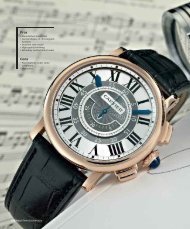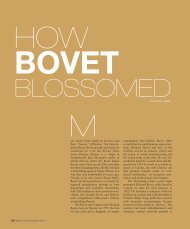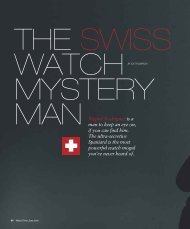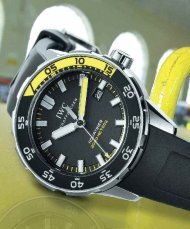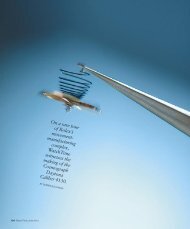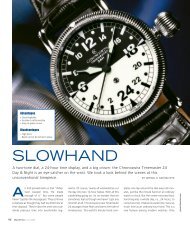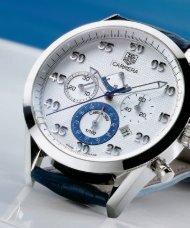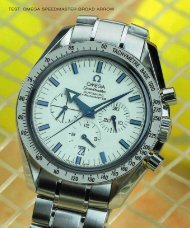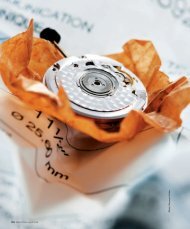WT_2001_06: INTERVIEW: ALAIN SILBERSTEIN
WT_2001_06: INTERVIEW: ALAIN SILBERSTEIN
WT_2001_06: INTERVIEW: ALAIN SILBERSTEIN
- No tags were found...
You also want an ePaper? Increase the reach of your titles
YUMPU automatically turns print PDFs into web optimized ePapers that Google loves.
<strong>INTERVIEW</strong>: <strong>ALAIN</strong> <strong>SILBERSTEIN</strong>COLOROn White II byWassily Kandinski.Copyright Giraudon/Art Ressource N.Y.Alain Silberstein first shocked anddelighted the world at the 1987 Basel Fair.In the last 14 years his attention to detailand sheer sense of fun has earnedhim a permanent place in today’sworld of watches.<strong>INTERVIEW</strong>ED BY MATTHEW MORSEWith his slightly outré mustache,funky wristwatches and a wildgleam in his eye, Alain Silbersteinis the enfant terrible of the very conservativeworld of haute horology. But the truth is,we’re extremely lucky to have him. With influencesrunning the gamut from George Danielsto Alexander Calder, Danish spoons andFinnish Vodka, his watches synthesize some ofthe most interesting mechanical and designparadigms of the last two hundred years. Youcan call it a postmodern hodgepodge, buteven the most ardently right-wing wristwatchaficionado has to admit that there are momentswhen he’d like to own one of Silberstein’ssignature timepieces. He’s probablymost known for his connection with theBauhaus movement – a German school foundedin 1919 by Walter Gropius that sought tosynthesize design and technology with traditionalhandcraftsmanship. Although it wasclosed down in 1933 by the Nazis, the questionsthat the Bauhaus raised – about how artand craft should be taught, about the natureof good design, about the effects buildingshave on people who live in them – are still beingasked in the 21st century. Numerous wristwatcheshave been created under Bauhaus influence,including the Movado MuseumWatch (1965), the Nomos Tangente (1992),Xemex watches (1996) and, of course, theAlain Silberstein Krono Bauhaus (1987). AlthoughI had met him a number of times at theBasel Fair, the following interview took placeover the telephone while he was at his office inBesançon, France.134 WatchTime December <strong>2001</strong>
& FormWatchTime: Let’s start from the beginning,you were born in Paris, right?Silberstein: Yes, I was born in Paris in 1950.But, for the last 20 years I’ve lived in a town ineastern France called Besançon.WatchTime: And what brought youthere?Silberstein: I guess you could call it Fate. When Iwas 13 I received a Lip watch for my BarMitsvah…and, Lip watches were made in theFrench watchmaking capitol of Besançonwhich is much closer to Geneva, Switzerlandthan it is to Paris. But the more obvious reasonthat I moved here was that my wife Sylvie and Iprefer to work together and were both offeredjobs as interior designers by the same company.WatchTime: That’s right, you have abackground as an industrial designer.Silberstein: Yes, I went to the School of AppliedArts in Paris, where I studied industrial designand hotel architecture. Before my watchmakingcareer took off I worked for ten years creatinghotel and restaurant spaces.Alain SilbersteinDecember <strong>2001</strong> WatchTime 135
<strong>INTERVIEW</strong>: <strong>ALAIN</strong> <strong>SILBERSTEIN</strong>WatchTime: And when did you becomeinterested in the Bauhaus school of design?Silberstein: It was even before I went to college,when I was about 19-year-old. I went to aprep school in Paris and the headmaster therewas my Bauhaus mentor.WatchTime: Of course the Bauhaus wasa school in Germany that ran from1919-1933, and quite a few differentpeople taught there: Walter Gropius,Johannes Itten, Wassily Kandinsky,Paul Klee and Mies van der Rohe,among others. Which one of thesemodernists would you say has influencedyou the most?Silberstein: As far as color, Kandinsky and Klee.But, of course one of the fundamental principlesof Bauhaus modernism – and this wasshared by everyone there – is the reduction ofall design to the simplest possible shapes andcolors. Once you find these underlying formsyou can build a world out of them.WatchTime: Right, and didn’t Kandinskydecide that the red square, the bluecircle and the yellow triangle were the"primary" shape/color objects. But, Inotice that your watches often use aThe back of theFlying Tourbillon.red triangle, a yellow circle and a bluerectangle or square.Silberstein: Well, Kandinsky’s theory is a littlebit too rigid for me. I just try to reduce thingsstep-by-step until I reveal the forms that areuseful for my particular project. At a certainstage of your work you will always know whenyou hit upon the right thing. Besides, I’m aFrenchman so I’m allowed to take a little liberty.Nevertheless, I travel throughout the worldand I do feel that when I work in this way I’mtapping into a universal language that peoplefrom many different cultures can relate to.WatchTime: How and when did youmake your first wristwatch?Silberstein: When I moved to Besançon – theheart of French watchmaking – I started to designfashion watches. And then it happened:In 1985 my most recently purchased Lip brokedown and I said to myself, "I live in the centerof French watchmaking and I’m a designer. I’llmake my own watch." Around the same timea gentleman showed me a catalog of mechanicalmovements that his company had just purchased.The company was Valjoux. At the timethey didn’t have any idea what they wanted todo with the company…make quartz watches,or what? Luckily, they had an old stock of Valjoux7750s and 7751s. I fell instantly in lovewith the 7751 because it had a moon-phasecomplication.WatchTime: And was your first Silbersteinwatch a chronograph?Silberstein: Yes, and by 1987 I had a third-floorbooth at the Basel Fair, directly across from theAHCI (The Academy of Independent Watchmakers).WatchTime: And legend has it that youhad a very good response from theJapanese.Silberstein: That’s right, the fellow I met fromJapan that year is still my distributor, and Japanis still my biggest market. The U.S. and Russiaare my two other largest markets.WatchTime: And why do you thinkyour watch is "big in Japan."Silberstein: My watches appeal to different culturesfor different reasons. The Japanese arejust as interested in functional design as weare, and have been for thousands of years.Some Japanese people have told me that thelines (not the colors) of my timepieces speak totheir pre-Buddhist Shinto traditions. And as forthe United States, The Chicago school of architecturecomes straight out of the Bauhaus traditionthrough the work of Mies van der Rohe,among others. 6th Avenue in New York is thesame. Many Americans are fortunate enoughto live among beauty and structure, and theywant a wristwatch that lives up to it.WatchTime: Interesting. Ruedi Küllingof Xemex once told me pretty much thesame thing. Of course, he comes out ofthe same design tradition as you.Silberstein: Yes, he’s more of a purist – veryblack and white. I like his watches a lot.WatchTime: How many watches doyou make a year?Silberstein: About 2,000. The most I wouldever want to produce is 4,000, anything morethan that is a different business. I’m an artistand a craftsman, and to produce 10,000 ormore watches is a marketing game that isn’tso interesting to me.WatchTime: How many people work inyour company?Siberstein: Well there’s my wife Sylvie who’s mymain collaborator. And, then there are 20 otherpeople, six of whom are watchmakers. Weall work in one building. After I come up with adesign, I present my idea to my wife, and if shesays no then I have to go back to my drawingtable.WatchTime: So do you try to come outwith two or three new watches everyyear.Silberstein: What? Two or three? No, my realgoal is to try to create classics. For instance myoriginal chronograph from 1987, the KronoBauhaus, lasted for about 10 years…I like towork the way that BMW used to – rather thanspinning out lots of new product I want tomake a reliable statement that has stayingpower.WatchTime: Are you a big BMW fan?Silberstein: I’m not a real fan of branding. I justlove a good creation, I don’t care whetherChrysler, Mercedes, BMW, Honda or Fordmakes it. The same goes for watches: Jaeger-LeCoultre makes some amazing watches, but Iwouldn’t say they’re a better brand than Blancpain…eachcompany makes some nice things.WatchTime: Kind of like the old challengeof looking at a painting in a mu-136 WatchTime December <strong>2001</strong>
seum before you read the name of theartist who did it. The quality or sensationof the work is more importantthan the name of the painter or wherehe was born.Silberstein: Exactly.WatchTime: I notice that you go formovements that are slightly more obscurethan the basic 2892-A2.Silberstein: But, as I’m sure you know, not allValjoux 7750s are created equal. Some arestraight out of the box and some have beenpainstakingly hand-finished. People are alwaysimpressed that I care so much about thecaliber, but a gorgeous mechanical movementcan express all of the structural aesthetics thata finely made bridge can, and as we know, notall bridges are created equal. It’s Architecture.The biggest difference between architectureand movement design is scale…you have tostart thinking in microns instead of millimeters.A skeletonized movement has to playwith lines, materials, finishing and color. I’veworked with Lémania 5100s, Frédéric Piguet1185s, AS caliber 5008 alarm movements, aswell as custom-made movements by AS, andof course, the custom-made Progress caliberin my Flying Tourbillon. My goal is to integratethe architecture of the movement with the designof the case and dial. Because I’m interestedin the beauty of the movement itself, I’vealways used clear case backs with my watches.WatchTime: The Flying Tourbillon isprobably the best example of this. It’squite amazing how it ties together the18th century restraint of Abraham-Louis Breguet with the 20th centurymodern primitivism of the Bauhaus. Itreally packs a lot of cultural weightinto a tiny instrument for the wrist.Silberstein: Thanks. With that watch I had achance to work with Progress in designing myfirst movement. It took me two years to finishthat, but I feel really good about the tourbilloncage and the escapement. If you look closelyyou might notice that the escapement has atiny image of the yin-yang symbol.WatchTime: Do you lean towards Taoism?Silberstein: A little…I’ve read the Tao Te Ching.And, I certainly think it’s appropriate for a tourbillon(French for whirlwind) that circles 360degrees once a minute. But, in my real life Istick closer to the Judaism of my forefathers.WatchTime: Do you study the Kabala?Silberstein: Oh no, you have to wait untilyou’re 60-years-old to even begin to studythat…you can’t try to push these things.WatchTime: Who do you consider yourliving horological heroes?Silberstein: It would have to be George Danielsand François-Paul Journe [to read a profile ofMr. Journe see the February <strong>2001</strong> issue ofWatchTime]. It was through Daniels that Ilearned about sandblasting certain parts of aThe Flying Tourbillon.The entire collectionof Silbersteinwatches can be seen atwww.alainsilberstein.commovement such as the bridges. I thought thatthis English tradition had a certain modernistauthenticity that suited my purpose. I also havea great deal of respect for the members of theAHCI (The Academy of Independent Watchmakers),especially Svend Andersen.WatchTime: I imagine that like a lot ofpeople your creative ideas come fromeverywhere – books, music, movies,people – and then they stew in yoursubconscious before you begin to testthem on paper….Silberstein: That’s right. We all take things in,and then something such as a remark, a commentor an image can kick start the process ofmaking something. But my biggest influenceis the people I meet. I love to travel throughoutDecember <strong>2001</strong> WatchTime 137
<strong>INTERVIEW</strong>: <strong>ALAIN</strong> <strong>SILBERSTEIN</strong>Europe, and as a Frenchman I straddle the linebetween the Mediterranean influence of Italyand Spain and the northern sensibility of Germanyand Scandinavia. I’m always meetingpeople that inspire me at shows or now in mynew gallery in Paris.WatchTime: So you’re rather gregarious,and learn more from people thanfrom books?Silberstein: Yes, definitely. I’m always interestedin the fact that when you walk into an artgallery one person might be especially movedby a particular painting, while someone elsehas strong feelings for a different object.WatchTime: Speaking of painting, doyou have any favorite artists?Silberstein: I’m not really a collector. I like tomake things myself. But if I had limitlessamounts of money, I’d buy the works of WassilyKandinsky and Paul Klee. Especially Klee. Ilike his childlike playfulness and sense of humor.I also like Alexander Calder, Miro andsculptors such as Alberto Giacometti and Brancusi.But, to tell you the truth, I don’t reallymake a distinction between "high" art such asPicasso and "low" art such as a Giorgio Armanifashion show…I’m interested in creativeexpression and beauty of all types. On the otherhand I don’t really care for the American Popart (Andy Warhol etc.) of the 1960s…I think it’sderivative and highly overrated.WatchTime: Now that your Flying Tourbillonis complete what’s on the boilerplateright now.Silberstein: I’m working on my WindowWatch. It’s a watch without a crown, dial andhand…it has a little widow on the side of thecase that tells the time.WatchTime: And when you’re notworking, what do you like to do?Silberstein: I like to go hiking in the mountains.I’m a volunteer with a local Boy Scout troop.WatchTime: And you have a couple ofkids, right?Silberstein: Yes, I have a 27-year-old daughterwho practices architecture in Paris and a 25-year-old daughter who’s a fashion designer,also in Paris. My son is 22, and is involved incomputer design here in Besançon. The designgenes are quite strong in my family.WatchTime: Was your father a designeralso?Silberstein: No, he was a Polish Jew whomoved to Paris and started a tailoring business.He was a businessman.WatchTime: Have you also traveled toplaces like Africa and Australia?Silberstein: No, I’m fine sticking to Europe. It’s agathering of cultures and languages that neverbores me. I love Italy, but I also have a greattime in Finland. And the Danes have such afeeling for making the everyday object a thingof beauty: tableware, furniture and stereo systems,for instance. I love to travel to a capitalcity in Europe – Paris, Milan, London – andspend two or three days there.WatchTime: As an industrialdesigner youneed to see machinemadeobjects madebeautiful, but whatabout the importanceof the handcrafted?Silberstein: It would be incrediblydepressing if mywatchmaking work couldbe done completely bymachine. The only pleasurefor me is the fact thatthese things can only bedone by hand. I was reallyhonored to use an enameldial on one of my watchesyears ago. I’m a designer,but it’s important to methat I need artisans to fulfillmy ideas. Years ago Icame out with a quartzwatch. Not only did it lackcharacter; it was extremelyeasy to copy, which is anotherreason that I like touse mechanical movementsthat are a little lesserknown.WatchTime: Here inAmerica we don’t reallyhave a strongtradition of the handcrafted.It’s funny, wemake genius movies,music and books butnot too many peoplehere can make a good chair.Silberstein: Well, you do have some nicelycrafted items, but it’s true, different cultureshave different strengths. In the German-speakingcountries there’s more respect for the traditionof the handmade (especially when itcomes to metal) than in the Latin countries(which care more about cloth and textiles). InFrance, we don’t care as much as we should.WatchTime: But when it comes to winethe French do care, right?Silberstein: Definitely. And most watch enthusiaststhat I’ve met tend to know about qualitywine, food, shoes, cars and clothes. An appreciationfor one thing can veryeasily open up a taste for another.WatchTime: What kind offood do you most enjoy.Silberstein: I don’t really likethe stuffy haute cuisine establishments.Give me themore provincial fare in aplace that’s made for meetingwith friends.WatchTime: And music?Silberstein: I like just aboutany kind of music: rock, jazz,classical as well as folk traditionsfrom around the world.I don’t like to work to music,but it’s a big part of my life.Except rap. I don’t like rapmusic, sorry!WatchTime: What kind ofpeople do you think buyyour watches?Silberstein: I don’t know, Isuppose people who are selfpossessedand don’t care toostrongly about the opinionsof others. Partisan peoplewith strong tastes. I thinkabout half are watch connoisseurswho really knowwhat they’re getting and theother half are just "normal"people who are fortunateenough to have some funwith their money. Most of mywatches are purchased bymen.138 WatchTime December <strong>2001</strong> An exploded view ofthe Flying Tourbillon.



